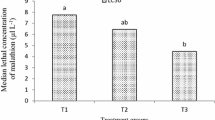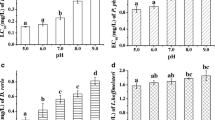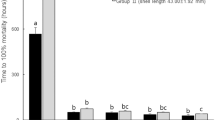Abstract
The present investigation aimed to evaluate acute toxicity of an emergent pollutant, triclosan (TCS), in Pangasianodon hypophthalmus under the influence of varied temperatures and pH. Degradation of TCS in aqueous solution was estimated under in vitro condition at different temperatures and pH separately and in combination. Further, the effect of temperature (25, 30 and 35 °C) and pH (6.5, 7.5 and 8.5) on the acute toxicity of TCS for fish was evaluated. The combined effects of temperature and pH showed the highest degradation of TCS at temperature 35 °C and pH 7.5. The lowest 96-h LC50 of TCS for P. hypophthalmus was observed at 25 °C and pH 6.5. Moreover, in the combinatorial study, the exposed fishes showed marked clinical signs of acute stress such as air-gulping, respiratory distress and overproduction of mucus on the surface of the body with varying degrees depending upon the concentration of TCS. Therefore, the environmental concentrations of TCS in different habitats may have different manifestations on aquatic organisms and might be applied in future screening level for ecotoxicological risk assessments.




Similar content being viewed by others
References
Pal A, Gin KYH, Lin AYC, Reinhard M (2010) Impacts of emerging organic contaminants on freshwater resources: review of recent occurrences, sources, fate and effects. Sci Total Environ 408(24):6062–6069. https://doi.org/10.1016/j.scitotenv.2010.09.026
Dietrich S, Ploessl F, Bracher F, Laforsch C (2010) Single and combined toxicity of pharmaceuticals at environmentally relevant concentrations in Daphnia magna—a multigenerational study. Chemosphere 79(1):60–66. https://doi.org/10.1016/j.chemosphere.2009.12.069
Vera-Candioti L, Garcia MG, Galera MM, Goicoechea HC (2008) Chemometric assisted solid-phase microextraction for the determination of anti-inflammatory and antiepileptic drugs in river water by liquid chromatography–diode array detection. J Chromatogr A 1211(1–2):22–32. https://doi.org/10.1016/j.chroma.2008.09.093
Gavrilescu M, Demnerova K, Aamand J, Agathos S, Fava F (2015) Emerging pollutants in the environment: present and future challenges in biomonitoring, ecological risks and bioremediation. N Biotechnol 32(1):147–156. https://doi.org/10.1016/j.nbt.2014.01.001
Petrie B, Barden R, Kasprzyk-Hordern B (2015) A review on emerging contaminants in wastewaters and the environment: current knowledge, understudied areas and recommendations for future monitoring. Water Res 72:3–27. https://doi.org/10.1016/j.watres.2014.08.053
Dhillon GS, Kaur S, Pulicharla R, Brar SK, Cledón M, Verma M, Surampalli RY (2015) Triclosan: current status, occurrence, environmental risks and bioaccumulation potential. Int J Environ Res Public Health 12(5):5657–5684
Ricart M, Guasch H, Alberch M, Barcelo D, Bonnineau C, Geiszinger A, Ferrer J, Ricciardi F, Romani AM, Morin S, Proia L (2010) Triclosan persistence through wastewater treatment plants and its potential toxic effects on river biofilms. Aquat Toxicol 100(4):346–353. https://doi.org/10.1016/j.aquatox.2010.08.010
Sorensen JPR, Lapworth DJ, Nkhuwa DCW, Stuart ME, Gooddy DC, Bell RA, Chirwa M, Kabika J, Liemisa M, Chibesa M, Pedley S (2015) Emerging contaminants in urban groundwater sources in Africa. Water Res 72:51–63. https://doi.org/10.1016/j.watres.2014.08.002
Allmyr M, Harden F, Toms LML, Mueller JF, McLachlan MS, Adolfsson-Erici M, Sandborgh-Englund G (2008) The influence of age and gender on triclosan concentrations in Australian human blood serum. Sci Total Environ 393(1):162–167. https://doi.org/10.1016/j.scitotenv.2007.12.006
Pycke BF, Roll IB, Brownawell BJ, Kinney CA, Furlong ET, Kolpin DW, Halden RU (2014) Transformation products and human metabolites of triclocarban and triclosan in sewage sludge across the United States. Environ Sci Technol 48(14):7881–7890. https://doi.org/10.1021/es5006362
Zhao JL, Ying GG, Liu YS, Chen F, Yang JF, Wang L (2010) Occurrence and risks of triclosan and triclocarban in the Pearl River system South China: from source to the receiving environment. J Hazard Mater 179(1–3):215–220. https://doi.org/10.1016/j.jhazmat.2010.02.082
Ramaswamy BR, Shanmugam G, Velu G, Rengarajan B, Larsson DJ (2011) GC–MS analysis and ecotoxicological risk assessment of triclosan, carbamazepine and parabens in Indian rivers. J Hazard Mater 186(2):586–1593. https://doi.org/10.1016/jjhazmat.2010.12.037
Nag SK, Das Sarkar S, Manna SK (2018) Triclosan–an antibacterial compound in water, sediment and fish of River Gomti, India. Int J Environ Health Res 28(5):461–470. https://doi.org/10.1080/09603123.2018.1487044
Canosa P, Morales S, Rodriguez I, Rubi E, Cela R, Gomez M (2005) Aquatic degradation of triclosan and formation of toxic chlorophenols in presence of low concentrations of free chlorine. Anal Bioanal Chem 383(7–8):1119–1126. https://doi.org/10.1007/s00216-005-0116-4
Kishino T, Kobayashi K (1995) Relation between toxicity and accumulation of chlorophenols at various pH, and their absorption mechanism in fish. Water Res 29(2):431–442. https://doi.org/10.1016/0043-1354(94)00189-E
Gupta S, Dalela RC, Saxena PK (1983) Influence of temperature on the toxicity of phenol and its chloro-and nitro-derivatives to the fish Notopterus notopterus (PALLAS). Actahydrochim Hydrobiol 11(2):187–192
Bostrom ML, Berglund O (2015) Influence of pH-dependent aquatic toxicity of ionizable pharmaceuticals on risk assessments over environmental pH ranges. Water Res 72:154–161. https://doi.org/10.1016/j.watres.2014.08.040
Kanetoshi A, Ogawa H, Katsura E, Kaneshima H, Miura T (1988) Formation of polychlorinated dibenzo-p-dioxin from 2,4,4′-trichloro-2′-hydroxydiphenyl ether (Irgasan® DP300) and its chlorinated derivatives by exposure to sunlight. J Chromatogr A 454:145–155. https://doi.org/10.1016/S0021-9673(00)88609-4
Lindstrom A, Buerge IJ, Poiger T, Bergqvist P, Muller MD, Buser H (2002) Occurrence and environmental behavior of the bactericide triclosan and its methyl derivative in surface waters and in wastewater. Environ Sci Technol 36(11):2322–2329. https://doi.org/10.1021/es0114254
Bedoux G, Roig B, Thomas O, Dupont V, Le Bot B (2012) Occurrence and toxicity of antimicrobial triclosan and by-products in the environment. Environ Sci Pollut Res 19(4):1044–1065. https://doi.org/10.1007/s11356-011-0632-z
Mezcua M, Gomez MJ, Ferrer I, Aguera A, Hernando MD, Fernandez-Alba AR (2004) Evidence of 2,7/2,8-dibenzodichloro-p-dioxin as a photodegradation product of triclosan in water and wastewater samples. Anal Chem Acta 524:241–247
Kim JW, Ishibashi H, Yamauchi R, Ichikawa N, Takao Y, Hirano M, Koga M, Arizono K (2009) Acute toxicity of pharmaceutical and personal care products on freshwater crustacean (Thamnocephalus platyurus) and fish (Oryzias latipes). J Toxicol Sci 34(2):227–232. https://doi.org/10.2131/jts.34.227
Shashikumar BN, Pandey PK, Kumar K, Kumar S (2018) Increase in temperature induces the malathion toxicity in Pangasianodon hypophthalmus: a short term acute test. Proc Nat Acad Sci India Sect B Biol Sci 88(2):553–557. https://doi.org/10.1007/s40011-016-0787-y
Kumar N, Krishnani KK, Brahmane MP, Gupta SK, Kumar P, Singh NP (2018) Temperature induces lead toxicity in Pangasius hypophthalmus: an acute test, antioxidative status and cellular metabolic stress. Int J Environ Sci Technol 15(1):57–68. https://doi.org/10.1007/s13762-017-1364-5
Orvos DR, Versteeg DJ, Inauen J, Capdevielle M, Rothenstein A, Cunningham V (2002) Aquatic toxicity of triclosan. Environ Toxicol Chem 21(7):1338–1349. https://doi.org/10.1002/etc.5620210703
Ishibashi H, Matsumura N, Hirano M, Matsuoka M, Shiratsuchi H, Ishibashi Y, Takao Y, Arizono K (2004) Effects of triclosan on the early life stages and reproduction of medaka Oryzias latipes and induction of hepatic vitellogenin. Aquat Toxicol 67(2):167–179. https://doi.org/10.1016/j.aquatox.2003.12.005
Nassef M, Matsumoto S, Seki M, Khalil F, Kang IJ, Shimasaki Y, Oshima Y, Honjo T (2010) Acute effects of triclosan, diclofenac and carbamazepine on feeding performance of Japanese medaka fish (Oryzias latipes). Chemosphere 80(9):1095–1100. https://doi.org/10.1016/j.chemosphere.2010.04.073
Sahu VK, Karmakar S, Kumar S, Shukla SP, Kumar K (2018) Triclosan toxicity alters behavioral and hematological parameters and vital antioxidant and neurological enzymes in Pangasianodon hypophthalmus (Sauvage, 1878). Aquat Toxicol 202:145–152. https://doi.org/10.1016/j.aquatox.2018.07.009
Drummond RA, Russom CL (1990) Behavioral toxicity syndromes: a promising tool for assessing toxicity mechanisms in juvenile fathead minnows. Environ Toxicol Chem 9(1):37–46. https://doi.org/10.1002/etc.5620090106
Liang X, Nie X, Ying G, An T, Li K (2013) Assessment of toxic effects of triclosan on the swordtail fish (Xiphophorus helleri) by a multi-biomarker approach. Chemosphere 90(3):1281–1288. https://doi.org/10.1016/jchemosphere.2012.09.087
Ghosh S (2018) Wastewater-fed aquaculture in East Kolkata wetlands: state of the art and measures to protect biodiversity. In: Wastewater management through aquaculture. Springer, Singapore, pp 119–137. https://doi.org/10.1007/978-981-10-7248-2_6
Gupta S (2016) Pangasius pangasius (Hamilton, 1822), a threatened fish of Indian Subcontinent. J Aqua Res Dev 7:400
Lu H, Ma H, Tao G (2009) Spectrophotometric determination of triclosan in personal care products. Spectrochim Acta A Mol Biomol Spectrosc 73(5):854–857. https://doi.org/10.1016/j.saa.2009.04.007
US EPA US Environmental Protection Agency (2008) Revised environmental fate science chapter for the triclosan reregistration eligibility decision (RED) document. Reregistration Case No.: 2340. US Environmental Protection Agency, Office of Prevention, Pesticides and Toxic Substances, Washington (DC), 42 pp
EPA (Environmental Protection Agency) (2002) Methods for measuring the acute toxicity of effluents and receiving waters to freshwater and marine organisms, 5th edn. 275. https://www.epa.gov/sites/production/files/2015-08/documents/acute-freshwater-and-marine-wet-manual_2002.pdf
APHA AW (1998) Standard Methods for the examination of water and wastewater, 20th edn. American Public Health Association/American Water Works Association/Water Environment Federation, Washington
American Public Health Association, APHA (2005) Standard methods for the examination of water and wastewater, 21st edn. American Public Health Association, Washington, p 1220
Finney DJ (1971) Probit analysis, 3rd edn. Cambridge University Press, Cambridge
Melin ES, Jarvinen KT, Puhakka JA (1998) Effects of temperature on chlorophenol biodegradation kinetics in fluidized-bed reactors with different biomass carriers. Water Res 32(10):81–90. https://doi.org/10.1016/S0043-1354(97)00184-X
Loftin KA, Adams CD, Meyer MT, Surampalli R (2008) Effects of ionic strength, temperature, and pH on degradation of selected antibiotics. J Environ Qual 37(2):378–386. https://doi.org/10.2134/jeq2007.0230
Lydy MJ, Lohner TW, Fisher SW (1990) Influence of pH, temperature and sediment type on the toxicity, accumulation and degradation of parathion in aquatic systems. Aquat Toxicol 17(1):27–44. https://doi.org/10.1016/0166-445X(90)90010-M
Barman BN, Preston HG (1992) The effects of pH on the degradation of isothiazolone biocides. Tribol Int 25(4):281–287. https://doi.org/10.1016/0301-679X(92)90065-U
Lohner TW, Fisher SW (1990) Effects of pH and temperature on the acute toxicity and uptake of carbaryl in the midge, Chironomus riparius. Aquat Toxicol 16(4):335–353. https://doi.org/10.1016/0166-445X(90)90045-Q
Montaseri H, Jamali F, Rogers JA, Micetich RG, Daneshtalab M (2005) The effect of temperature, pH, and different solubilizing agents on stability of taxol. Iran J Pharm Res 1(1):43–51
Howe GE, Marking LL, Bills TD, Rach JJ, Mayer FL (1994) Effects of water temperature and pH on toxicity of terbufos, trichlorfon, 4-nitrophenol and 2, 4-dinitrophenol to the amphipod Gammarus pseudolimnaeus and rainbow trout (Oncorhynchus mykiss). Environ Toxicol Chem 13(1):51–66. https://doi.org/10.1002/etc.5620130109
Maharjan S, Sharma R, Husoy T, Dirven H, Andreassen M, Lie B (2015) Modeling and simulation of Triclosan kinetics and distribution in humans using a PBPK model. In: Proceedings of the 56th SIMS. Linkoping, Sweden. https://doi.org/10.3384/ecp15119279
Brown VM, Jordan DHM, Tiller BA (1967) The effect of temperature on the acute toxicity of phenol to rainbow trout in hard water. Water Res 1(8–9):587–594. https://doi.org/10.1016/0043-1354(67)90041-3
Holcombe GW, Fiandt JT, Phipps GL (1980) Effects of pH increases and sodium chloride additions on the acute toxicity of 2, 4-dichlorophenol to the fathead minnow. Water Res 14(8):1073–1077. https://doi.org/10.1016/0043-1354(80)90155-4
Carvalho CS, Fernandes MN (2006) Effect of temperature on copper toxicity and hematological responses in the neotropical fish Prochilodus scrofa at low and high pH. Aquaculture 251(1):109–117. https://doi.org/10.1016/j.aquaculture.2005.05.018
Acknowledgements
The first author expresses sincere gratitude to the Indian Council of Agricultural Research (ICAR) providing Junior Research Fellowship during the entire study period. The authors are also thankful to the Director & Vice-chancellor, ICAR-Central Institute of Fisheries Education (CIFE), Mumbai, and Head of Department, Aquatic Environment and Health Management Division, ICAR-CIFE, Mumbai, for providing all possible facilities to complete this research work successfully.
Funding
This work was supported by ICAR-Central Institute of Fisheries Education (CIFE), Mumbai, India.
Author information
Authors and Affiliations
Corresponding author
Ethics declarations
Conflict of interest
The authors declare no conflict of interest to publish this manuscript. All institutional guidelines for the animal care and use were strictly followed.
Additional information
Publisher's Note
Springer Nature remains neutral with regard to jurisdictional claims in published maps and institutional affiliations.
Significance Statement
In the present study, the rate of degradation of triclosan is increased at higher temperatures and near-neutral pH. The low level of temperature and pH in combination elevates the acute toxicity of triclosan in fish.
Rights and permissions
About this article
Cite this article
Paul, T., Shukla, S.P., Kumar, K. et al. Effects of Temperature and pH on Acute Toxicity of Triclosan in Pangasianodon hypophthalmus (Sauvage, 1878). Proc. Natl. Acad. Sci., India, Sect. B Biol. Sci. 90, 677–685 (2020). https://doi.org/10.1007/s40011-019-01143-4
Received:
Revised:
Accepted:
Published:
Issue Date:
DOI: https://doi.org/10.1007/s40011-019-01143-4




